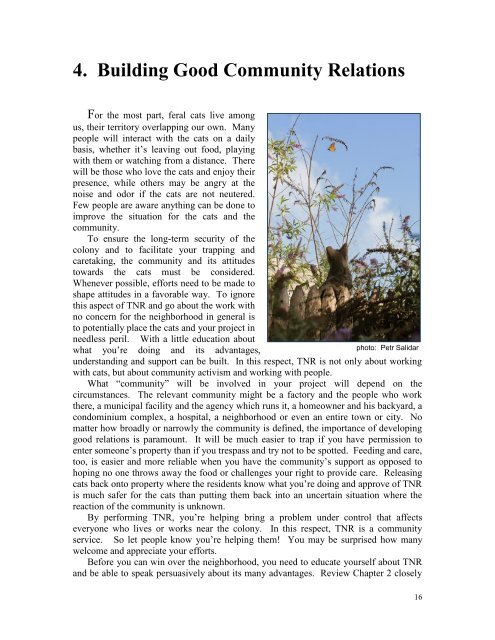download/print - Neighborhood Cats
download/print - Neighborhood Cats
download/print - Neighborhood Cats
- No tags were found...
Create successful ePaper yourself
Turn your PDF publications into a flip-book with our unique Google optimized e-Paper software.
4. Building Good Community RelationsFor the most part, feral cats live amongus, their territory overlapping our own. Manypeople will interact with the cats on a dailybasis, whether it’s leaving out food, playingwith them or watching from a distance. Therewill be those who love the cats and enjoy theirpresence, while others may be angry at thenoise and odor if the cats are not neutered.Few people are aware anything can be done toimprove the situation for the cats and thecommunity.To ensure the long-term security of thecolony and to facilitate your trapping andcaretaking, the community and its attitudestowards the cats must be considered.Whenever possible, efforts need to be made toshape attitudes in a favorable way. To ignorethis aspect of TNR and go about the work withno concern for the neighborhood in general isto potentially place the cats and your project inneedless peril. With a little education aboutwhat you’re doing and its advantages,photo: Petr Salidarunderstanding and support can be built. In this respect, TNR is not only about workingwith cats, but about community activism and working with people.What “community” will be involved in your project will depend on thecircumstances. The relevant community might be a factory and the people who workthere, a municipal facility and the agency which runs it, a homeowner and his backyard, acondominium complex, a hospital, a neighborhood or even an entire town or city. Nomatter how broadly or narrowly the community is defined, the importance of developinggood relations is paramount. It will be much easier to trap if you have permission toenter someone’s property than if you trespass and try not to be spotted. Feeding and care,too, is easier and more reliable when you have the community’s support as opposed tohoping no one throws away the food or challenges your right to provide care. Releasingcats back onto property where the residents know what you’re doing and approve of TNRis much safer for the cats than putting them back into an uncertain situation where thereaction of the community is unknown.By performing TNR, you’re helping bring a problem under control that affectseveryone who lives or works near the colony. In this respect, TNR is a communityservice. So let people know you’re helping them! You may be surprised how manywelcome and appreciate your efforts.Before you can win over the neighborhood, you need to educate yourself about TNRand be able to speak persuasively about its many advantages. Review Chapter 2 closely16








